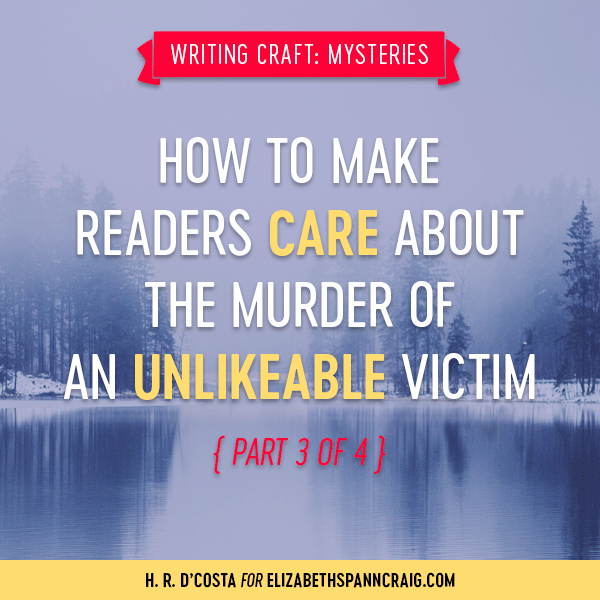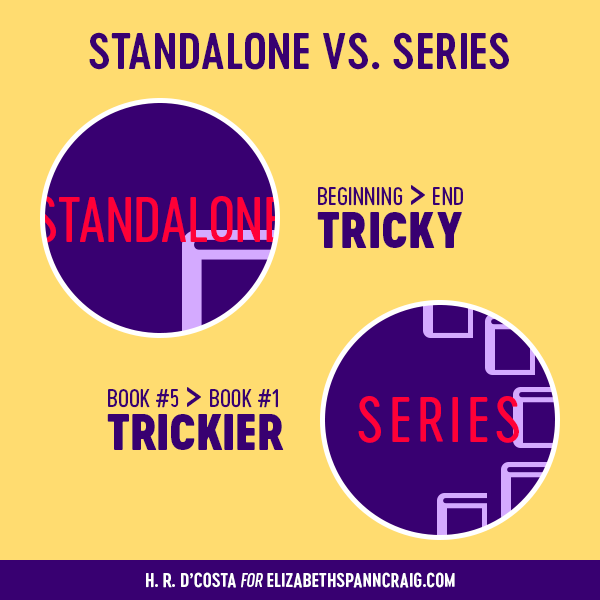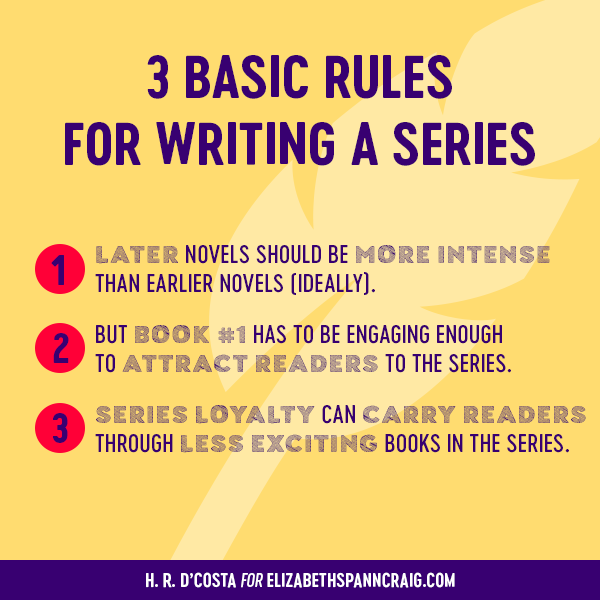
by H.R. D’Costa, @scribesworld
Standalone or series.
It’s a dilemma that many novelists face.
But for authors of cozy mysteries, the decision’s almost a foregone conclusion: series.
By all accounts, that’s what fans of the subgenre enjoy (especially the tropes they encounter again and again). That’s what fans expect.
Plus, as our blog host Elizabeth Spann Craig explains, writing a book for a series is oftentimes easier than writing a standalone because:
Usually everything after book one has already been established…You’ve already developed the main characters and the huge amount of work that goes along with that is mainly finished. The groundwork has been laid and you can focus on other aspects of your story.
In short, writing in a series is a win for you as well as for your readers. However, it does come with a complication that standalone novels don’t.
Before I get into specifics, let me just share a quick reminder. This post is part of an ongoing blog series about how to handle the stakes in a cozy mystery. (By the way, although the illustrative examples are cozy-centric, many of the tips in this series can be applied to mysteries with a harder edge.)
Parts 1 and 2 set the context for this post, so I strongly recommend that you read them first (if you haven’t already) before continuing.
Below, you’ll find an overview of the topics in this blog series, with convenient links to Parts 1 and 2:
- In Part 1, we covered methods to bolster the stakes that emphasize the sleuth.
- In Part 2, we covered methods to bolster the stakes that emphasize other storytelling elements that readers care about.
- In Part 3, we’ll discuss considerations to take into account when applying these story stake tips to cozy mysteries in a series. (You’re reading Part 3 right now.)
- In Part 4 (forthcoming), you’ll see these considerations in action when I share a sample lineup of stakes for a hypothetical cozy-mystery series.
Okay, with that overview in place, let’s return to that complication I mentioned earlier—the one you’ll have to face if you’re writing a cozy-mystery series (as opposed to a standalone).
The Special Problem You Face When Writing a Series
With any novel, you need to keep tabs on escalation.
Your plot should become progressively more interesting as it goes along.
If it doesn’t—if say, for example, all your genre elements are front-loaded into the first half of your story—everything that follows will feel anticlimactic in comparison, ultimately creating a dissatisfying reader experience.
But with a series, you have an additional burden.
You have to worry not only about the escalation within each individual book in the series, but also about how the series escalates as a whole. That is to say, based on how you developed the plots of your books, readers may feel like your series went downhill after a certain point.
A Common Mistake Made with the First Book in a Cozy-Mystery Series
Now that you’re aware of the issue with escalation, let’s bring it back to the topic of this blog-post series—handling the stakes in a mystery when the victim is unlikeable—and put all the pieces together.
An unlikeable victim can be advantageous because this situation generates plenty of suspects, which’ll keep your plot lively.
At the same time, it comes with a major drawback: readers might not care about solving the case. Why should they invest in catching the killer of an unlikeable person?
As one solution, instead of building the stakes around achieving justice for the sake of the victim, you build them around saving the sleuth protagonist from terrible consequences—e.g. being charged with the murder herself.
Due to the high stakes, readers will become emotionally invested in the plot.
Indeed, because of the appeal of these stakes, many novelists gravitate toward using this setup (the protagonist is the prime suspect) for the first book in their series.
However, although this can be an excellent way to convince readers to give your cozy-mystery series a chance, you can run into a problem down the line.
You started your series with the protagonist in an emotionally intense situation…which means you haven’t really given yourself room to escalate.
Although subsequent books ARE interesting in their own right, compared to the first book, they might not feel AS interesting.
In sum, readers could feel like your series went downhill after book #1, and abandon your series midway through it. Fortunately, it’s easy to avoid this outcome. Take a look…
3 Operating Principles to Maintain the Appeal of Your Cozy-Mystery Series
How to maintain the appeal of your series in the long run?
Simple. Just map out the plot for each book in the series in advance, and assess each one’s impact on how the series escalates as a whole.
By mapping out, we’re talking broad strokes here, so this is something both “plotters” and “pantsers” can do. Although, it must be said, the more details you know ahead of time, the more you can take advantage of that knowledge in later books.
When you do this, keep the following three operating principles in mind.
- Ideally, the novels in your series will be more emotionally intense, as your series goes along.
- However, the first book in your series should be engaging enough to lure readers into your series.
- Series loyalty can carry readers through books that might not be as exciting as previous books in a series.
* * *
By adhering to the three principles listed above, you should be able to figure out how to preserve escalation across all the books in your cozy-mystery series.
But, before you do this on your own, you might like to see these principles in action, and get a sense of the reasoning process you’ll be going through. Happily, that’s the topic of the next (and last) post in this four-part blog series. See you then!
In the meantime, if you’d like to dig deeper into story stakes, download this cheat sheet with 11 types of story stakes. It might (a) give you additional ideas for how to make readers emotionally invested in the outcome of the case as well as (b) help you generate a variety of motives to match your healthy list of suspects.
You can also check out my writing guide Story Stakes: Your #1 Writing Skills Strategy to Produce a Page-Turner That Transforms Readers into Raving Fans of Your Screenplay or Novel . See below for details on how you could win a paperback copy…
Win a Paperback Copy of Story Stakes
For every post in this blog series, you have a chance to win a paperback copy of Story Stakes ($15.95).
Described as “a must-have in your top 10 books on writing” by one Amazon reviewer, it’ll show you how to use story stakes to elicit the maximum degree of emotion from readers as well as how to raise the stakes (even when they’re already high!).
For a chance to win today, answer this question in the comments: Besides escalation, what are other challenges that you face when writing a series?
Elizabeth will randomly select four lucky winners by Monday, August 19.
Note: This giveaway is only open to residents of North America, South America, and Europe.
Good luck and happy writing!
About H. R. D’Costa

A graduate of Brown University, H. R. D’Costa (a.k.a. HRD) is an author and writing coach who specializes in story structure and story stakes.
Known for her “deep dive” instruction style, she is the author of 8 writing guides including Sizzling Story Outlines , Story Stakes, and the 4-volume Story Structure Essentials series .
For practical, actionable writing tips designed to help you keep readers glued to your pages, visit her website scribemeetsworld.com, which is also home to the Ultimate Story Structure Worksheet (downloaded over 37,000 times by writers from around the world).
One Common Mistake Mystery Writers Make When Handling Unlikeable Victims (by @scribesworld ): Share on XIMAGE CREDITS: Coffee & book by Amariei Mihai; Misty lake by Dominik Dombrowski; Detective in a trench by Shawn Liew





Increasing the intensity of any series is a must and huge challenge. I think I managed to do that with my series, but now that I am working on a fourth (unplanned) book (well, technically, I didn’t plan on any of them), I’m working overtime trying to make it more intense. I guess I might have to blow up the entire galaxy to do it…
This is a great series!
You’re right, Alex. Increasing the intensity of any series is challenging.
It seems like now that you started working on your fourth book, you have a good plan in place!
Also, don’t forget the value of series loyalty–especially if it’s been a long time between now and your last release. Your fans will be so delighted to get a new book from you, the escalation issue could potentially be moot.
PS: Thanks for the kind words. I’m so glad you’re enjoying this blog-post series :)
Series loyalty is huge!
I’d say one of the challenges of a long-running series is keeping all the elements that readers like about a series while making each book fresh. :) Thanks for the great series of posts, HRD!
That’s a good way to put it, Elizabeth.
It shows another reason why writing a standalone could be considered easier than writing a series. Because you don’t have to include long-running series elements, everything may feel fresh.
Speaking of series loyalty, JA Konrath wrote an interesting post on it, and how it affects his wife’s purchasing habits. Reader comments are interesting too.
I posted the link below. (There’s a curse word in the title, and hence the link. Hope that’s okay.)
http://jakonrath.blogspot.com/2019/05/on-writing-shit.html
PS: Thanks, Elizabeth, for hosting me today…and on the other days of this blog series too :)
Thanks for this! I haven’t seen this post by Konrath…I appreciate the link!
Great tips on how to write any series, not just cozy mysteries. And keeping the main character interesting and growing can be important too.
Thanks so much for reading, Natalie!
That’s a good point about character growth. It’s great way to keep readers invested in your series over the long haul.
Something I hadn’t thought about – increasing the tension in each book! Great points and something I’ll be taking to heart.
So glad, Jemi, that maintaining escalation (across books in a series) is now on your radar.
Awesome!!
Avoiding plot holes.
Plot holes are annoying little buggers, that’s for sure!
The neat thing, Melody, is that stakes can help you out here, too. Due to the stakes, it’s believable that a character would go to extreme lengths…even to the point of acting out of character.
In a nutshell, if you remind readers what’s at stake and/or raise the stakes, you can advance the plot, without sacrificing character. (Keaton in THE USUAL SUSPECTS is a good example.)
One of my primary challenges hasn’t been escalation as much as it’s been keeping readers invested in characters they’ve grown to love and keep demanding to know more about.
I’ve got a long-running mystery series that isn’t a cozy series because my sleuth is a professional (a sheriff). I made a decision some time ago to allow each mystery to stand alone with maybe a teaser at the end for the next story, but to let all of the characters grow and change over time. Where with many series, take popular ones by Janet Evanovich and the late Sue Grafton as examples, you could pick up any book and get a sense of who all of the regulars are and what they’re like every day, day in and day out. With my books, you miss a lot of the story that got them to that point in their lives. You’ll know who they are right now, but not who they were.
Doing it this way isn’t for everyone. It doesn’t work if you want books a reader can pick up in any order. It works great though for readers who like to binge and see all aspects of a character’s life and journey. For me, it’s led to a spin-off actual cozy series involving my sheriff’s mother and also to several romance book spin-offs for other characters in the mystery series.
Anne, I love how you created a cozy spin-off of your sheriff series using your sheriff’s mother.
That’s a brilliant strategy. Should give authors who write in series lots of food for thought!
Like Jemi, I hadn’t thought about increasing the tension in subsequent books. Something for me to keep in mind as I work on book #4 in my current series.
Good luck, Ellen, with book #4!
Don’t forget…at this point, you’ll have series loyalty to lean on (if creating escalation proves trickier than expected).
PS: Maybe you can bring back the dolphin spit vs. snot debate? It won’t help with escalation…but it sure would be fun :)
Excited to follow along on this blog series. I currently write a middle-grade mystery series and am setting up to write a cozy mystery series with a pen name. I have lots to absorb here…thanks!
Hi Brenda, thanks for stopping by!
How cool that you are branching out into a new genre. I hope the tips in this blog-post series will prove useful as you embark on this exciting adventure!
Elizabeth has also written a great series of blog posts on how to write a cozy mystery. I linked to a lot of them within this series, so those would be good to check out.
This one has a template to work with, so it might be a good starting point:
https://elizabethspanncraig.com/mystery-writing-tips/outlining-cozy-mystery/
In answer to the question: “Welcoming” the reader who wants to start in the middle by giving enough information, preferably efficiently and without a narrative dump, while polishing the back story probably with humor so readers who have been along for the whole ride are not bored. Then there is doing it differently in the next one … then doing it differently in the next one …
Oh, that’s a dilemma a lot of series writers struggle with, for sure.
As you noted, it’s a tricky issue to deal with because you have to deal with two sets of readers:
(1) the ones who’ve been with you from the beginning, and know all the backstory (perhaps even better than you, the author, does!) and (2) the ones who’ve just stumbled across your series and are reading a book in it for the first time.
By the way, Maren, love your name!
Besides escalation, what are other challenges that you face when writing a series?
Part of the challenge to writing a series is keeping the characters fresh, and letting them grow. We love our series characters, so we don’t want them to change too much. Just enough to satisfy that character arc.
That’s a good point, Gwen.
Our characters should change — but not to the point of become unrecognizable!
One of the things I found a challenge (other than above discussed), was making interesting or likeable characters the protagonist either knows, or comes into contact with.
Thinking in terms of proportion might help you out here, Lorelei.
Hypothetically speaking, let’s say you gave readers 10 reasons to love your protagonist.
For a character the protagonist knows, or comes into contact with, you’d scale down, giving similar reasons…but only 1 or 2 of them.